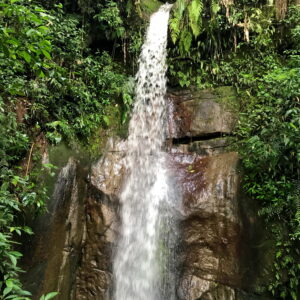Alarachi Natural Reserve is an area of significant biological diversity, located in the heart of South America.
Military macaws and golden monkeys frolic among its ancient and mystical trees – trees that soar to touch clouds, some as high as 2,500m above sea-level.
Sheltered by the lush forest canopy, jaguars, tapirs, peccaries and over 400 other registered fauna, all roam freely across this protected virgin forest landscape.
We have strong partnerships with local Bolivian environmental NGOs and with the local forest community of Padcaya.
We also have local and international private sector partners who we are working with in the development of new products that offer economic opportunities for the local community.
Our ambition is to create a model for what is possible in a relatively small area of cloud-forest working in collaboration with the local community of Padcaya.
What do we do?
We have three primary areas of focus:
- Wildlife and Forest Conservation: We raise funds to train local community members in forest management skills and offer a park ranger training program.
- New Product Development: We work with the forest community of Padcaya to develop products that offer economic opportunities that will improve their livelihoods whilst maintaining the integrity of the forest.
- Cloud-forest Network: Through outreach and research, we aspire to become a resource hub to deepen our understanding of cloud-forests.
Why is Alarachi so important?
Alarachi serves as an ecological corridor
This 6,062ha private reserve provides a bridge, an ecological corridor, connecting two National Cloud-forest reserves: Tariquia in southern Bolivia and Baritu, in Northern Argentina. Corridors such as these are critical to the survival of a great number of species, in particular the jaguar.
Climate Change & Water capture
Cloud-forests have the highest water capture rates of any ecosystem on the planet as they receive water not only from rainfall but also by maximising absorption of mist from the clouds given their high elevation. The water from Alarachi’s forested slopes charge steady water supplies to the Bermejo River, which flows from Bolivia into Argentina and Paraguay, feeding the wetlands of the Gran Chaco. Under climate change or lowland land clearing, lowered relative humidity at altitude means clouds will form at higher elevations, reducing the area of intersection with mountains and decreasing the extent of cloud forest, causing loss of some of the endemic species found there.
Deforestation
Globally we are all affected when forests such as these are cut down. But those most affected by deforestation are the communities that surround them. Research has shown that forests managed by indigenous and local communities have lower deforestation rates and release less CO2 than those managed by governments.



